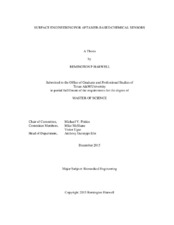| dc.description.abstract | Bisphenol A (BPA) is a common chemical intermediate associated with adverse reproductive effects, cancer, and other human health disorders. Despite these risks, BPA continues to be employed worldwide towards the production of various plastics, resulting in widespread exposure. Recent regulations have restricted the use of BPA somewhat; however, these limitations may not be sufficient to mitigate its detrimental effects. Thus, development of a novel BPA sensor capable of rapid detection in complex biological media is paramount to adequately understand and preclude the dangers associated with BPA use.
To develop such a device, DNA aptamer probes were anchored onto a glass substrate via silanization. As a proof-of-concept, these probes were specific for a model DNA target. To achieve detection, the device was first loaded with a fluorescently-labelled version of the DNA target. This modified target could then be competitively displaced upon exposure to the native (label-free) target, which was expected to result in a loss of fluorescence corresponding to the amount of native target.
Initial results revealed that a reproducible surface for probe attachment could be achieved after 15 minutes of silanization. Probe immobilization was characterized via ellipsometry, XPS, and UV/Vis studies. These results were inconclusive; however, subsequent fluorescent target binding studies evinced reproducible binding in a quantitative manner. Moreover, minimal binding occurred in the absence of probe, implying a highly specific mechanism consistent with aptamer probe immobilization. Thus, it is suspected that aptamer probes were reproducibly anchored onto the substrate via this method. A high concentration of reducing agent was paramount for such reproducibility, with appropriate use of blocking agents and wash buffers exerting control over sensor noise.
Subsequent competitive binding studies demonstrated the feasibility of native target detection, with a loss of fluorescence correlated with increasing native target exposure. Nevertheless, such results lacked reproducibility and did not correlate well with previous fluorescent target binding data. As a result, key areas for future research include further characterization of the probe surface and optimization of the competitive binding process to enable reproducible, sensitive detection in complex media. | en |


